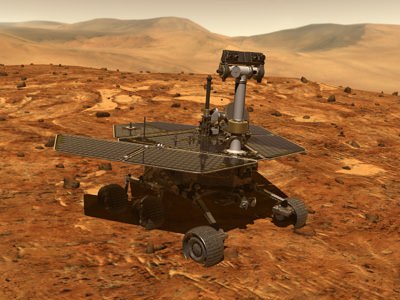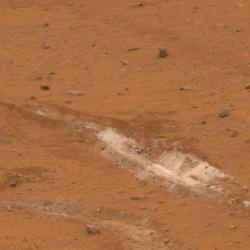[/caption]
One of the most successful mission ever sent to Mars is the Mars Exploration Rover program, with the two rovers Spirit and Opportunity. They were launched separately to Mars in 2003 and landed safely several months later. They were supposed to last about 3 months on the surface of Mars, but have now survived more than 5 years.
Spirit and Opportunity used technology developed with the Mars Pathfinder mission. They used an airbag system to land on the surface of Mars without using retrorockets to touch down gently. They also use the rover technology first used with the Sojourner rover, but instead of operating from a base, Spirit and Opportunity were designed to be completely independent, able to communicate directly back to Earth.
The purpose of the Mars Exploration Rover mission (MER) was to search the surface of Mars for evidence of past water on the surface of Mars. Spirit landed in the huge Gusev Crater on Mars, a region that could have been an ancient lake on Mars. Opportunity touched down on the other side of the planet in a region called Meridiani Planum.
Both Spirit and Opportunity are equipped with solar panels that supply electricity to let them crawl around the surface of Mars, as well as their scientific instruments that let them study the surface of Mars and its rocks. They’re also equipped with a grinding tool that lets them scrape away the outer layer of rocks and see the material underneath.
Within just a few months of arriving on Mars, both Spirit and Opportunity fulfilled their mission objectives, and discovered evidence that large quantities of water used to be on the surface of Mars. Spirit discovered hints that water had acted on a rock called Humphrey, while Opportunity found layers of sedimentary rock that would have been formed by deposits in water. Both rovers continued to find additional evidence for the presence of water.
Over the course of their mission on the surface of Mars, both rover traveled several kilometers. Spirit climbed a small mountain, and Opportunity crawled into a large crater to sample the walls for evidence of past water. And both rovers continued to perform quite well, for many years beyond their original estimate life spans.
We have written many articles about the Mars Exploration Rovers for Universe Today. Here’s an article about the troubles for the Spirit rover, and here’s an article about Martian weather.
If you’d like more info on the rovers, you should check out the Mars Exploration Rover homepage from NASA.
We’ve also recorded several episodes of Astronomy Cast about the exploration of Mars. Start here, Episode 92: Missions to Mars, Part 1.
Source: NASA


